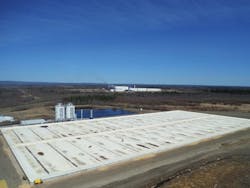Above: The gas collection cover provides a gastight seal over the reactor.
Wastewater treatment options at pulp and paper mills vary depending on the type of product produced, effluent characteristics, environmental regulations and treatment objectives. At many mills, pulp and paper wastewater has high organic strength due to chemical, thermomechanical and chemi-thermomechanical processes used in the industry. It may contain compounds that make it difficult to treat, but managing wastewater at pulp and paper mills is an important consideration that cannot be ignored.
The right solution for pulp and paper mill wastewater treatment allows mills to minimize both costs and environmental impacts of production. The following is the story of a pulp mill that used anaerobic digestion technology to simultaneously address a problem and save money. The goal of this Biomethanation and Power Generation Project was to capture, treat and utilize biogas naturally produced from the anaerobic treatment of the pulp mill’s wastewater.
Biogas scrubbing tanks biochemically convert sulfide in the biogas to sulfate.
Slave Lake’s High-Strength Stream
Slave Lake Pulp, a subsidiary of West Fraser Mills Ltd., is a 240,000-tonne-per-year, bleached-chemi-thermo-mechanical pulp (BCTMP) mill located in northern Alberta, Canada. The mill primarily processes aspen to produce market pulp for the global market.
Slave Lake Pulp generates a high-strength wastewater stream, which was being treated in an energy-intensive conventional activated sludge (CAS) system. The mill frequently alternates pulp brightness grades, resulting in fluctuations in the wastewater’s chemical oxygen demand (COD) concentrations from 5,000 to 19,000 mg/L. These fluctuations meant that process stability and the ability to handle variations in hydraulic and organic loads were important factors when selecting an anaerobic digestion system.
The company decided to explore bio-methane for power generation—both for its environmental and cost-saving benefits.
“We run very lean. We needed something that wasn’t going to be a big drain on our resources,” said Shannon Fehr, engineering superintendent for Slave Lake Pulp.
With assistance from the Climate Change and Emissions Management Corp. (CCEMC) and the Government of Alberta, Slave Lake Pulp embarked on a Biomethanation and Power Generation Project that would anaerobically digest pulp mill effluent to generate biogas to be used as green energy.
Seeking a Solution
Slave Lake Pulp chose ADI-BVF technology for the project, and ADI Systems designed and installed a 120,000 cu meter reactor for anaerobic effluent pre-treatment. The low-rate treatment system is believed to be the first in Canada for the pulp and paper sector.
The reactor was constructed as an earthen basin with a concrete perimeter wall lined with a geotextile underlay and geomembrane liner. A gas collection cover designed and installed by Geomembrane Technologies Inc. was used to provide a gastight seal over the reactor. The upgraded wastewater treatment system consistently achieves a high organic removal efficiency and biogas production rate, yet the technology is relatively simple and has few moving parts.
The Biomethanation and Power Generation project also included the installation of a BioGasclean biological scrubber system to reduce the hydrogen sulfide (H2S) content in the biogas generated from the BVF reactor. The system consists of two parallel 550 cu meter scrubbing tanks filled with packed media and Thiobacillus bacteria, which biochemically convert the sulfide in the biogas to sulfate. They are among the world’s largest biological scrubbers installed in terms of hydrogen sulfide load treated.
Biogas generated in the system migrates to the reactor cover perimeter, where blowers pull gas through the biogas scrubbing system, boost the gas pressure and transmit the scrubbed biogas to a set of three 3-MW gensets designed for biogas applications.
Digestion Discretion
The wastewater treatment system designed and installed for Slave Lake Pulp is helping the mill improve consistency of final effluent quality. The BVF reactor can handle swings and peaks in hydraulic and organic loads, and anaerobically digests more than 85% of the biochemical oxygen demand (BOD) load with no aeration and minimal mixing required.
Anaerobic pre-treatment has allowed Slave Lake Pulp to decommission two of the four existing aeration basins, simplifying the overall treatment system and reducing operating costs associated with traditional aerobic treatment systems. Furthermore, the gas collection cover is insulated to reduce heat loss in the reactor and improve Slave Lake Pulp’s environmental footprint by limiting the amount of greenhouse gases entering the earth’s atmosphere.
The system requires little operator attention and no granular sludge, and decreases sludge generation for the overall wastewater treatment system. Anaerobic digestion also has reduced chemical usage by 50% to 70% and has significantly reduced costs for electrical and sludge disposal associated with biological wastewater treatment.
Biogas generated during anaerobic digestion has provided Slave Lake Pulp with a green energy source; 10.4 GJ of biogas energy is generated per tonne of COD anaerobically removed, resulting in up to 6 MW of electrical power generation through biogas scrubbing and utilization.
The Biomethanation and Power Generation project has greatly improved the mill’s long-term economic sustainability and its commitment to the environment.


